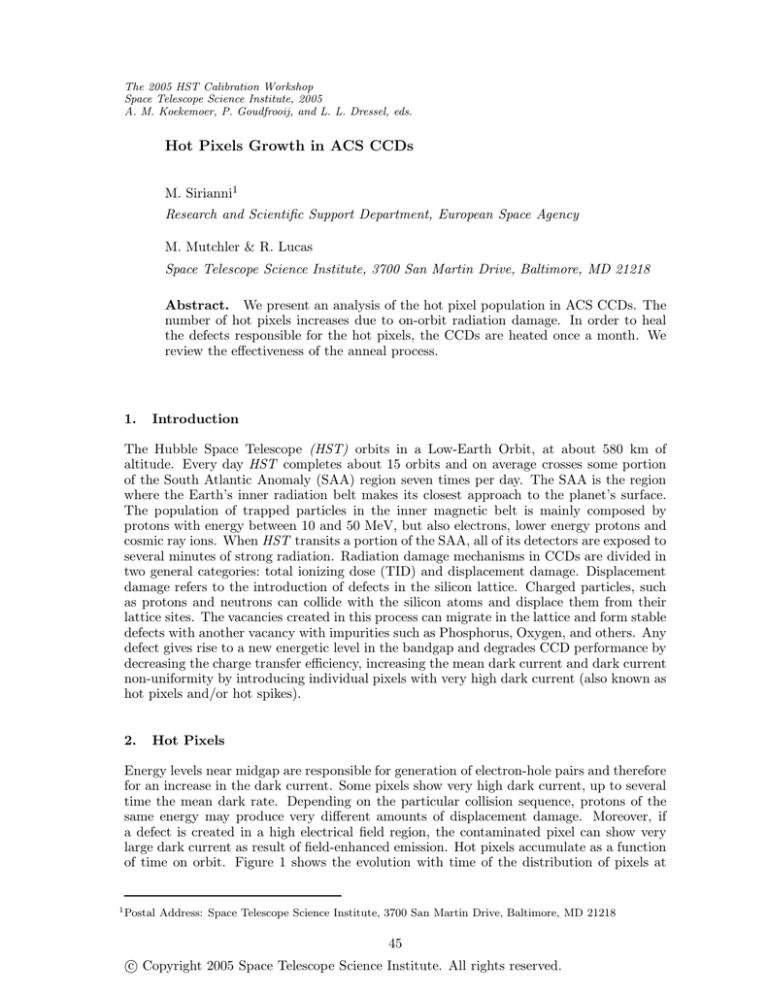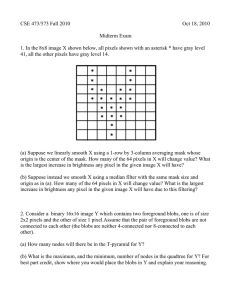
The 2005 HST Calibration Workshop
Space Telescope Science Institute, 2005
A. M. Koekemoer, P. Goudfrooij, and L. L. Dressel, eds.
Hot Pixels Growth in ACS CCDs
M. Sirianni1
Research and Scientific Support Department, European Space Agency
M. Mutchler & R. Lucas
Space Telescope Science Institute, 3700 San Martin Drive, Baltimore, MD 21218
Abstract. We present an analysis of the hot pixel population in ACS CCDs. The
number of hot pixels increases due to on-orbit radiation damage. In order to heal
the defects responsible for the hot pixels, the CCDs are heated once a month. We
review the effectiveness of the anneal process.
1.
Introduction
The Hubble Space Telescope (HST) orbits in a Low-Earth Orbit, at about 580 km of
altitude. Every day HST completes about 15 orbits and on average crosses some portion
of the South Atlantic Anomaly (SAA) region seven times per day. The SAA is the region
where the Earth’s inner radiation belt makes its closest approach to the planet’s surface.
The population of trapped particles in the inner magnetic belt is mainly composed by
protons with energy between 10 and 50 MeV, but also electrons, lower energy protons and
cosmic ray ions. When HST transits a portion of the SAA, all of its detectors are exposed to
several minutes of strong radiation. Radiation damage mechanisms in CCDs are divided in
two general categories: total ionizing dose (TID) and displacement damage. Displacement
damage refers to the introduction of defects in the silicon lattice. Charged particles, such
as protons and neutrons can collide with the silicon atoms and displace them from their
lattice sites. The vacancies created in this process can migrate in the lattice and form stable
defects with another vacancy with impurities such as Phosphorus, Oxygen, and others. Any
defect gives rise to a new energetic level in the bandgap and degrades CCD performance by
decreasing the charge transfer efficiency, increasing the mean dark current and dark current
non-uniformity by introducing individual pixels with very high dark current (also known as
hot pixels and/or hot spikes).
2.
Hot Pixels
Energy levels near midgap are responsible for generation of electron-hole pairs and therefore
for an increase in the dark current. Some pixels show very high dark current, up to several
time the mean dark rate. Depending on the particular collision sequence, protons of the
same energy may produce very different amounts of displacement damage. Moreover, if
a defect is created in a high electrical field region, the contaminated pixel can show very
large dark current as result of field-enhanced emission. Hot pixels accumulate as a function
of time on orbit. Figure 1 shows the evolution with time of the distribution of pixels at
1
Postal Address: Space Telescope Science Institute, 3700 San Martin Drive, Baltimore, MD 21218
45
c Copyright 2005 Space Telescope Science Institute. All rights reserved.
46
Sirianni, Mutchler, & Lucas
Figure 1: Distribution of dark pixels for one WFC CCD at launch (2002) (bottom), and
after 1,2, and 3 years on orbit.
different dark rate for one of the ACS/WFC CCDs as a function of time. As the protoninduced damage increases, the mean dark current (the peak of the distribution) and the
hot pixels population (the tail of the histogram) increase. For practical purpose we define
as “hot” all pixels with a dark rate greater than 0.08 e− /sec and as “warm” pixels whose
dark current is between 5σ of the main dark distribution and the hot pixel threshold. When
more than one image is available the ACS data pipeline by default rejects the pixels flagged
as “hot” pixels (see Mutchler et al. 2006, this volume)
The number of pixels with a dark current higher than the mean dark current increases
every day by few to several hundreds depending on their signal level (Table 1). Likely most
of these new hot pixels are transient.
Table 1: Daily growth of hot pixels
e− /pix/sec
0.02
0.04
0.08
0.10
1.00
HRC
136
98
68
36
1
WFC
824
607
489
390
16
The best approach to mitigate the impact of hot pixels in science frames is to dither
the observation by one or more pixels. Only warm pixels are properly corrected after the
subtraction of a ”dark frame” that brackets the observation. The population of hot pixels
for any given day is recorded in the Data Quality array of each image. For more on dithering
strategy, visit www.stsci.edu/hst/acs/proposing/dither.
Hot Pixels Growth in ACS CCDs
47
Figure 2: Determination of the anneal rate for the WFC CCDs. Dots show the population
of hot pixels above the threshold of 0.08 e− /pix/sec at each day. The vertical dashed lines
mark the annealing dates. After each anneal cycle, the number of hot pixels before the
anneal [A] drops to the level [B]. The ratio (A−B)/(A−C), where [C] is the population of
hot pixels at the end of the previous anneal cycle, determines the anneal rate for that cycle.
3.
Annealing of Hot Pixels
Like other CCDs on HST, the ACS detectors undergo a monthly annealing process. The
TECs are turned off and the heaters are turned on to warm up the CCD to ∼ 19 C for
a few hours. It is still not clear why at such low temperature a significant annealing is
observed: the most common defects anneal at much higher temperature. By comparing the
hot pixel population before and after each anneal (see Figure 2), it is possible to measure
the effectiveness of the anneal process.
The annealing rate is strongly dependent on the dark current of the hot pixel (Table
2). Very hot pixels show a higher anneal rate than warm pixels and there is no impact on
the average dark current level. Since launch, the duration of the CCD warming period has
been reduced from 24 hrs to 12 hrs and since spring 2005 to 6 hrs. No variation in the
annealing rate has been observed.
Pixels that do not anneal become permanently hot. The rate of growth of permanent
hot pixels depends on the signal level. At any threshold the number of hot pixels increases
linearly with time (Figure 3). By 2008 the number of pixels permanently hot will be similar
to the number of pixels contaminated by cosmic rays in a 1000 sec exposure.
It is interesting to follow the status of pixels that become hot due to radiation damage.
The four panels on Figure 4 show typical behaviors observed in hot pixels in ACS CCDs.
In each panel, the vertical lines show the annealing dates and the horizontal line marks the
threshold for hot pixel definition. The two panels on the top show two normal hot pixels
become hot and resume their normal status after the first anneal cycle. The plot on the
left shows a pixel that is fully healed. The one on the right is only partially healed; even
after the anneal the dark current of this pixel is more elevated than normal pixels, but it
remains below the hot pixel threshold. The two panels on the bottom of Figure 4 show
48
Sirianni, Mutchler, & Lucas
Table 2: Anneal Rate for ACS CCDs
Temp (C)
Annealing Temp
Annealing Time
Threshold
e-/pix/sec
> 0.02
> 0.04
> 0.06
> 0.08
> 0.10
> 1.00
WFC
-77
-10 to +20 C
6 to 24 hr
HRC
-81
-10 to +20 C
6 to 24 hr
%
0.55
0.70
0.78
0.82
0.84
0.55
%
0.64
0.84
0.84
0.87
0.85
0.64
±
0.02
0.07
0.04
0.03
0.02
0.15
±
0.02
0.07
0.04
0.03
0.02
0.15
pixels that, once damaged, respond to almost every anneal cycle. When they are hot the
annealing can restore their status, but subsequent anneals can activate it again as hot pixel
(reverse annealing).
4.
Lessons learned
• The anneal rate depends on the dark current level of the pixel (Table 2).
• The number of permanently hot pixels increases linearly with time. The only solution
to mitigate their presence is to dither the observations.
• The same anneal rate can be obtained at colder temperature. In at least four instances,
in occurrence of HST safing events, the temperature of the CCDs raised to only -10 C
for periods between 24 and 48 hours. After these periods the population of hot pixels
decreased by the same amount as in normal cycles at +20 C (Figure 5).
• The anneal rate does not seem to be related to the length of the anneal (Figure 5).
Figure 3: Growth of permanent hot pixels as a function of time for different signals.
Hot Pixels Growth in ACS CCDs
49
Figure 4: Dark current of selected hot pixels as a function of time (see text).
• For any particular hot pixel, a complete anneal is a rate event. Most of the annealed
hot pixels significantly reduce their dark current level but never rejoin the population
of normal dark pixels (Figure 4).
• Several hot pixels show evidence of reverse annealing. The process of heating the
CCD or simply a power cycle can cause previously-damaged pixels to change from
hot to normal and vice versa (Figure 4).
References
Mutchler, M., Sirianni, M., & Lucas, R. 2006, The 2005 HST Calibration Workshop. Eds.
A. M. Koekemoer, P. Goudfrooij, & L. L. Dressel, this volume, 51
Sirianni, M., & Mutchler, M. 2005, in 2005 Scientific Detector Workshop, eds. J. Beletic &
P. Amico (Garching: ESO)
50
Sirianni, Mutchler, & Lucas
Figure 5: Example of the analysis of hot pixels for WFC. Top: Anneal rate as a function
of time (left) and as a function of anneal frequency (right). MIDDLE: daily rate of hot
pixel creation as a function of time (left) and as a function of the anneal frequency (right).
BOTTOM: growth of permanently hot pixels.






